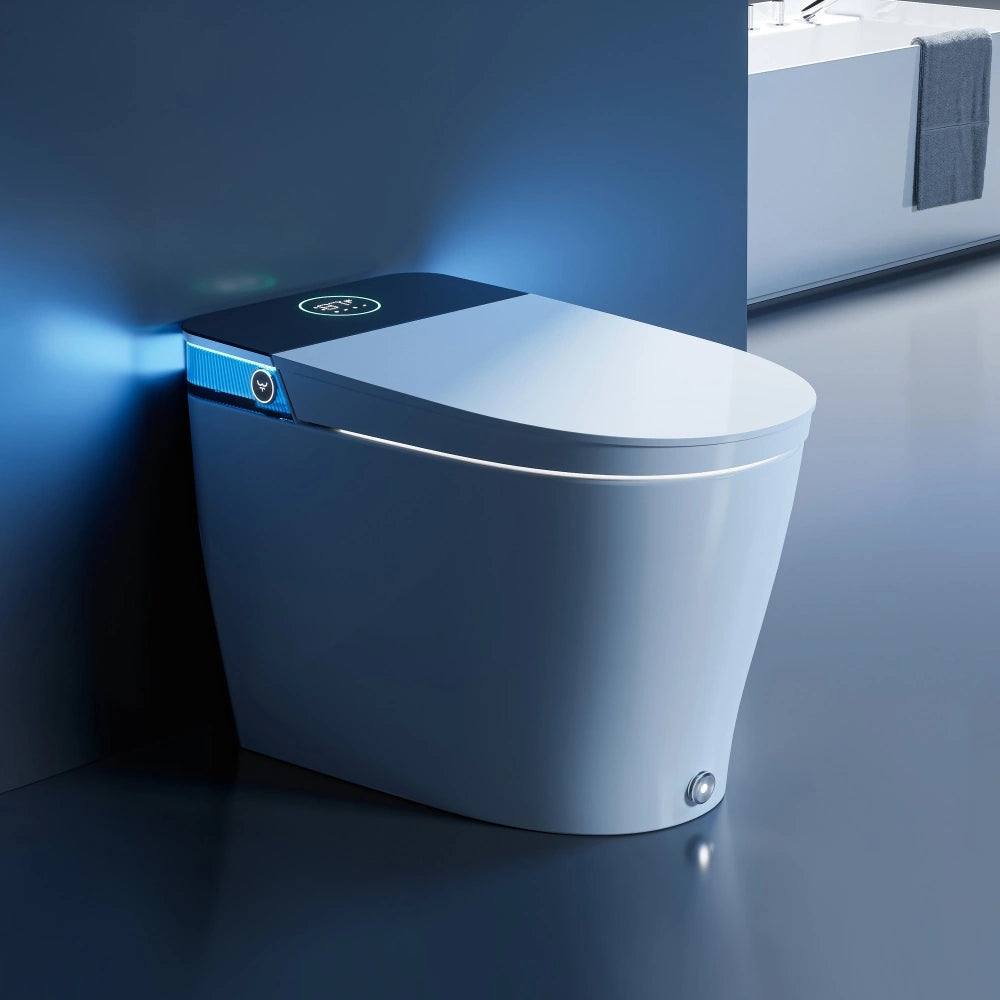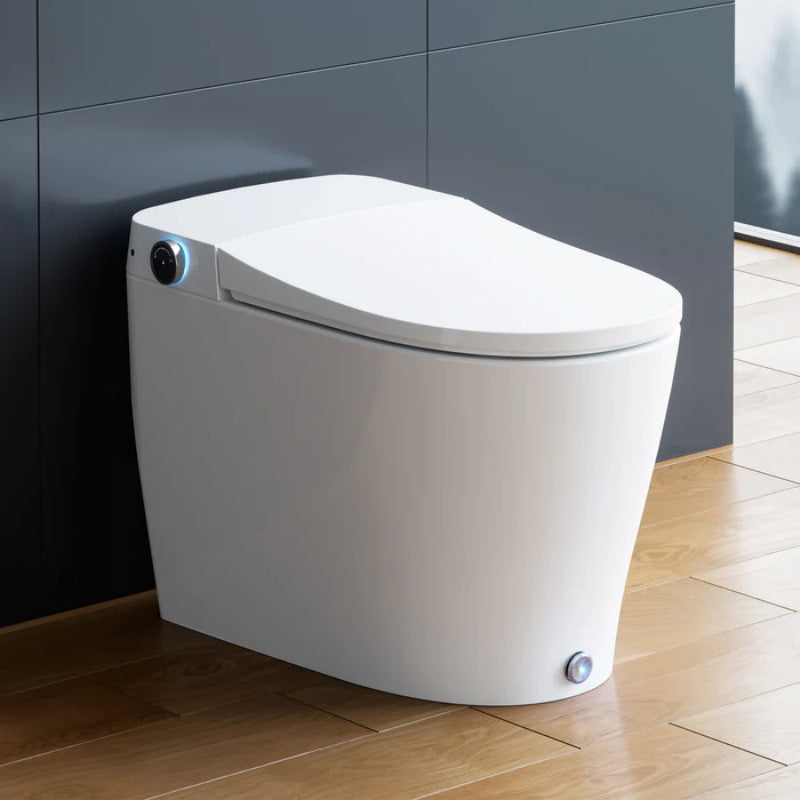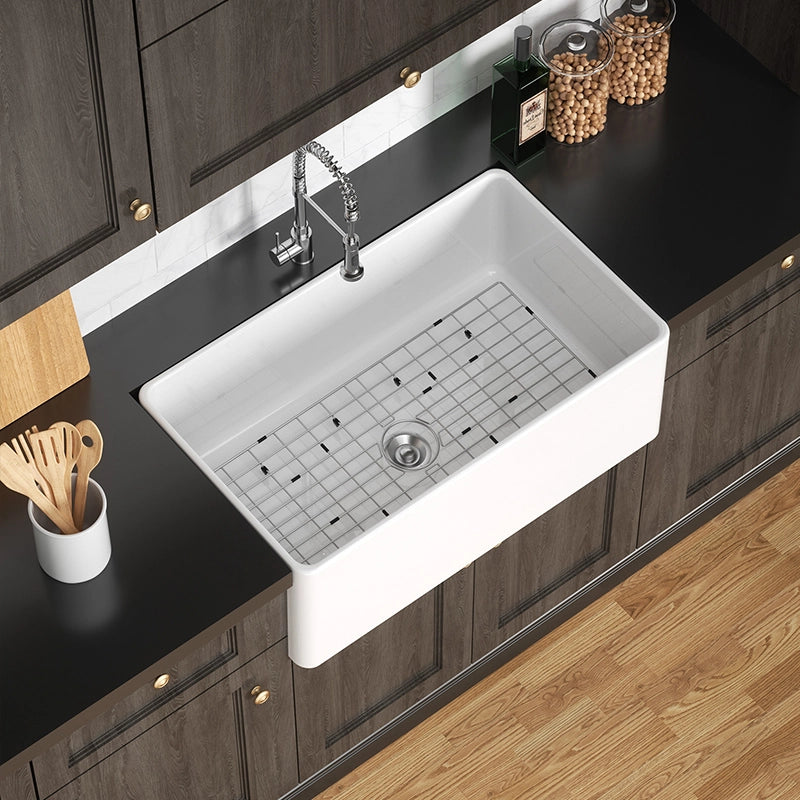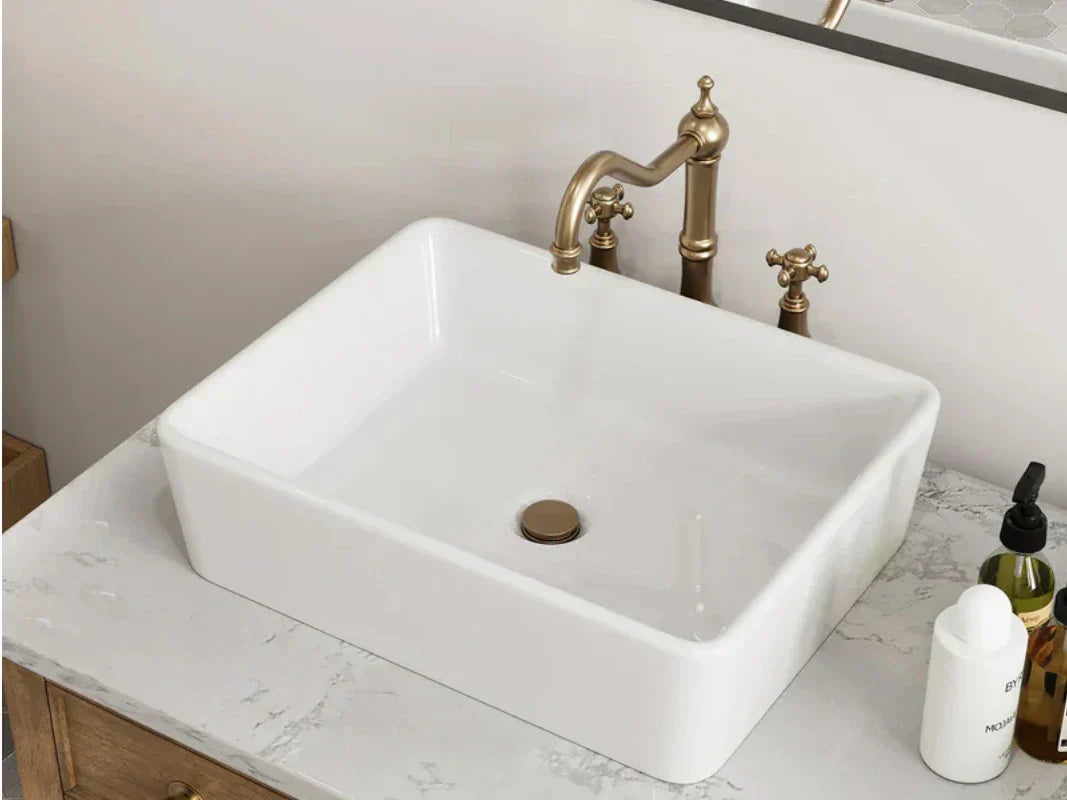Vessel sinks are above-counter, bowl-style bathroom basins that turn a vanity into a focal point. They are still popular in 2025 because they look high-end and install easily. This guide shows when they’re a good design choice, where they misfire, and how to choose the right bowl, faucet, and height so you don’t end up with splash or cleaning headaches.
Quick Verdict: Are Vessel Sinks Right for You?
Best for
-
Design-forward powder rooms and boutique/luxury bathrooms
-
Remodels needing quick visual upgrades without replacing the whole counter
-
Taller homeowners who like a higher wash height
Think twice if
-
You have kids or elderly users who need easier reach
-
You want the simplest cleaning routine
-
You’re sensitive to splash or countertop water spots
Fast facts
-
About 10–15% of luxury bathroom installs included vessel sinks in 2024–2025.
-
Expect a 20–35% cost premium over a basic undermount setup (materials + taller faucet).
-
Roughly 1 in 4 owners report regret, often due to splash and cleaning around the base.
1-minute decision checklist
-
Can you set the finished counter + rim height correctly for your users?
-
Do you have (or plan to add) a faucet with the right spout height and reach?
-
Are you okay cleaning the rim/counter junction where grime can build?
-
Will the lack of an overflow drain be acceptable in your home?
Vessel Sinks: Pros and Cons (2025)
A vessel sink is a type of sink that sits on top of the counter or vanity rather than being mounted below it. You see the full bowl, which can be round, square, oval, or sculpted. This look is bold, modern, and sometimes rustic or antique depending on the material and shape. But the same design that makes it eye-catching can create new challenges for everyday use.
Pros
-
Visual statement that can elevate a bathroom’s look quickly
-
Nearly endless material and shape options: ceramic, glass, stone, concrete, metal
-
Easier to install or swap than an undermount, which is great for remodels
-
Can support taller counter setups and may save minor counter space
-
Lets you repurpose unique basins for a custom, designer vessel sink feel
Cons
-
Splash risk if faucet spout height/reach does not match the bowl depth and shape
-
Exterior shows water spots; base can be difficult to clean
-
Added height can challenge kids and shorter users
-
Faucet compatibility is stricter, so choices are narrower
-
Most models lack overflow drains, raising flood risk if left running
-
Some materials chip or stain more easily; the look can feel trendy and date faster

How to Choose the Right Vessel Sink
Many people ask, what is a vessel sink and how do I pick one that actually works day to day? The key is to treat the bowl, faucet, and counter as one system. Shape, depth, spout height, and reach must align to control splash.
Materials guide
-
Ceramic/porcelain: Classic, widely available, affordable. Easy to clean and resists stains well. It can chip if hit hard with a heavy object.
-
Tempered glass: Light-catching and dramatic. Shows water spots and fingerprints more than ceramic. Needs gentle care; use non-abrasive cleaners.
-
Natural stone/concrete: Warm, artisanal look. Heavier and usually needs sealing to resist stains. Plan for resealing on a set schedule.
-
Metal (copper, stainless, brass): Bold and durable. Copper has natural antimicrobial properties. Some finishes patina over time; use mild cleaners.
Shape and size
The bowl shape affects how water behaves. Round and oval bowls tend to drain smoothly; square and flat-bottom basins can trap water unless designed with a slope.
Aim for
-
Width/diameter: 15–20 inches for most vanities
-
Interior depth: 4–6 inches for splash control
-
Bottom slope: avoid dead-flat bases; look for a positive slope toward the drain
Wider and shallow bowls can push water outward. Deeper basins reduce splash but can raise the finished rim height too much for shorter users. It’s a balancing act, so consider who will use the bathroom most.
Faucet pairing (splash reduction essentials)
The faucet and vessel must work together. This is where many regret stories start.
-
Spout height: Choose a spout that sits roughly 1–3 inches above the vessel rim. Too high and the stream falls hard and bounces; too low and washing your hands is awkward (EPA, 2025).
-
Spout reach: The water should land near the drain centerline. If it hits near the outer edge, expect splash and pooling.
-
Flow rate: Aerated 1.2–1.5 GPM helps reduce bounce and saves water.
-
Mount style: Tall single-hole faucets or wall-mounted faucets pair best with above-counter basins.
Countertop compatibility
Your counter or vanity needs to support the bowl base and the faucet holes you want. Solid-surface counters resist moisture and are easy to wipe around the base.
-
Make sure you have room for the faucet and the drain hardware.
-
Confirm hole sizes and spacing before you order. Vessel sinks usually need a single hole for the drain and a separate hole for the faucet unless the faucet is wall-mounted.
-
For stability, ensure the counter is flat and strong. Heavier stone bowls may require extra support.
Accessibility and ergonomics
Comfort matters. A quick rule is to set the finished rim height at about 34–36 inches for most adults. For a family bath with kids, aim lower or choose a semi-recessed bowl that drops partway into the countertop. Tall homeowners often love the extra height of a full above-counter vessel. Shorter users and children may prefer a lower set.
Installation Made Clear (Above-Counter, Semi-Recessed, Wall-Mount)
You can install a vessel sink in three common ways. Each changes the height, look, and splash behavior.
-
Above-counter: The bowl sits fully atop the counter. This install is simplest, often with only a drain hole in the counter. It’s great for remodels and rental-friendly changes.
-
Semi-recessed: The bowl drops into a larger cutout so the rim sits lower. This adds stability, reduces splash, and helps shorter users reach. It takes more counter work.
-
Wall-mounted bowl with wall faucet: The bowl hangs from the wall, saving counter space. It needs strong wall blocking and precise plumbing rough-ins.

Basic steps for a typical above-counter install
-
Dry-fit the vessel and faucet to test spout height, reach, and splash path.
-
Mark and drill the counter drain hole (and faucet hole if using a deck-mount faucet).
-
Place a mounting ring or gasket to level and support the bowl.
-
Set the bowl, align the drain, and apply a thin silicone bead at the base if the manufacturer calls for it.
-
Tighten the drain assembly, connect the P-trap, and check for leaks.
-
Install an appropriate pop-up drain compatible with no-overflow sinks.
-
Run a splash test. Adjust the aerator or flow if needed.
Pro tips
-
Always dry-fit to test water trajectory before drilling.
-
Use quality mounting rings/gaskets to prevent wobble.
-
If splash persists, swap to an aerated, lower-flow faucet or adjust spout reach.
-
Consider wall blocking during framing if you want a wall faucet or wall-mounted bowl.
Maintenance, Cleaning, and Troubleshooting
Daily and weekly care hinges on the material. The goal is to keep the exterior clean and the rim/counter junction sealed.
-
Ceramic/porcelain: Use non-abrasive bathroom cleaner and a soft cloth. Wipe water spots before they dry.
-
Tempered glass: Use a glass-safe cleaner or diluted vinegar, then dry with a microfiber towel to prevent spots.
-
Stone/concrete: Clean with a pH-neutral cleaner. Reseal on schedule (often every 6–12 months, follow the manufacturer’s guidance).
-
Metal: Use mild soap and water. Avoid harsh acids. Some metals will patina; that’s normal unless you prefer a polished look.
Rim/counter junction care
-
A thin, even silicone bead can stop leaks and grime buildup. Inspect it each year. If you see gaps, clean the area and re-apply a fresh bead.
Common issues and fixes
-
Persistent splash: Lower the faucet flow, swap to an aerated 1.2–1.5 GPM model, or choose a deeper bowl or a faucet with better reach toward the drain.
-
Slow drain: Avoid flat-bottom bowls. Clean hair and soap from the pop-up. Use no-overflow-compatible parts.
-
Wobble or leaks: Re-seat the mounting ring, re-apply silicone, and check trap alignment and tightness.
Do vessel sinks get dirty faster? Not inside, but the exposed exterior and base ring need more frequent wipe-downs than an undermount. If keeping a countertop spotless stresses you out, that’s a sign a traditional undermount might suit you better.
Costs and Value: Budgeting for Vessel Bathroom Sinks
Vessel bathroom sinks can cost more than a typical drop-in or undermount because the faucet often costs more and materials skew upscale. That said, install labor can be lower when you don’t have to cut a complex undermount hole or replace the entire counter.
Upfront cost ranges
| Item | Typical Range (USD) |
|---|---|
| Entry vessel (ceramic/glass) | 100–250 |
| Mid-range vessel | 250–700 |
| Luxury/artisan vessel | 700–2,500+ |
| Tall or wall-mount faucet | 120–600 |
| Drain/valves | 30–150 |
| Install labor | Often lower than undermount; varies by region |
Many homeowners see a 20–35% premium vs. a standard undermount setup when they include the faucet upgrade and, in some cases, sealing for stone. For trims and finishes, costs vary widely. If you love the look and plan the faucet/bowl pairing up front, the added spend can be worth it—especially in a powder room where the wow factor matters.
Long-term value
-
High design impact can help listing photos and resale appeal.
-
The trend factor is real. To avoid a “dated” look later, pick simple shapes, matte or soft-sheen finishes, and neutral tones.
-
For kids’ baths or heavy-use family bathrooms, the practical choice may still be a simple undermount.

Vessel Sinks vs. Undermount, Drop-In, Pedestal
Here is a quick comparison to help you decide which type of sink fits your bathroom and lifestyle.
| Feature | Vessel (Above-Counter) | Undermount | Drop-In | Pedestal |
| Style impact | High, eye-catching | Minimal, seamless | Moderate, traditional | Classic, space-saving visual |
| Install complexity | Easier; minimal cutout | Higher; precise cutout/support | Moderate; standard cutout | Higher; full plumbing exposure |
| Cleaning | Exterior and base need more care | Easiest; no rim on counter | Rim catches grime | Easy bowl; limited surface area |
| Splash control | Needs perfect faucet match | Forgiving | Moderate | Forgiving |
| Ergonomics | Adds height; great for tall users | Standard height | Standard height | Standard height, less counter area |
| Counter space | Can save minor space | Full counter around sink | Full counter with rim | Minimal counter; add shelves |
| Overflow drains | Rare | Common | Common | Common |
Are vessel sinks out of style? In 2025, no. They are still popular in boutique hotels, custom homes, and powder rooms. But the look is bold. If you choose a very trendy bowl or flashy glass, it might feel dated sooner. Pick a classic shape and finish to keep it fresh.
2025 Design Trends and What’s Next: Popular Vessel Sink Styles
Designers report continued use of vessel sinks in smaller rooms where a bold look has big impact. In 2025, you’ll notice:
-
Stone-look composites and matte ceramic with a soft, tactile finish
-
Hammered or brushed metals for a warm, crafted look
-
Taller mirrors and adjusted lighting to match the higher rim and sight lines
-
Semi-recessed installs to blend drama with better ergonomics
If you’re planning a remodel, future-proof by choosing neutral tones, classic oval or round bowls, and a semi-recessed set if you want easier day-to-day use.
Sustainability and Health Considerations
You can make a vessel setup greener and healthier with a few choices:
-
Pick eco materials like recycled glass or sustainably sourced wood in the vanity construction.
-
Use low-VOC sealers for stone or concrete so indoor air stays cleaner.
-
Pair with WaterSense-labeled faucets and aerators to cut flow without losing comfort.
-
Consider copper’s antimicrobial qualities if you like a living finish. For all materials, simple soap and water often clean well, which can reduce the need for harsh chemicals.
Real-World Lessons (What Owners and Pros Say)
Homeowners love the high-end look and the way a vessel sink makes a small powder room feel special. People often say guests comment on the design. Many DIY remodelers also appreciate that a vessel sits atop the counter, so there’s less cutting and easier swap-outs in the future.
The common regrets are familiar:
-
Splash from a faucet that is too tall or with a stream that hits the wrong spot
-
Flat-bottom bowls that pool water and leave a ring
-
A base ring that traps grime, causing a “difficult to clean” feeling
-
Height issues for kids or shorter users when paired with a tall vanity
A practical path is to test the splash before final install. Set your bowl and faucet in place, run the water, and watch the stream. If it hits near the drain and doesn’t bounce out, you’re close. If water sprays onto the counter, adjust the faucet reach or switch the aerator.
Summary and Next Steps
Key takeaways
-
Vessel sinks deliver standout style and flexible installation. They’re still a smart pick in 2025 for design-forward bathrooms.
-
Plan bowl shape/depth and faucet height/reach together to stop splash. Set a rim height that fits your users.
-
Choose materials that match your care routine. Ceramic is easiest; stone and metal need more specific cleaners and, sometimes, sealing.
What to do now
-
Measure your current vanity height and aim for a finished rim around 34–36 inches for most adults.
-
Pick the bowl depth and shape first. Then match a faucet so the stream lands near the drain, with 1–3 inches of clearance above the rim.
-
Confirm counter hole sizes, choose a no-overflow-compatible drain if needed, and dry-fit the setup to test splash before drilling.
-
If the bathroom is for kids or mixed-height users, consider a semi-recessed install for better ergonomics and less splash.
By treating the vessel, faucet, and counter as one system—and by keeping height and cleaning in mind—you can enjoy the drama of a countertop basin without the usual cons. If you ever wondered, are vessel sinks a good idea for my home, you now have a clear plan to say yes with confidence.

FAQs
1. Are vessel sinks a good idea?
Vessel sinks are a great choice for bathrooms where design impact matters. Their popularity comes from the way they transform a vanity into a centerpiece, adding a contemporary, eye-catching feel. When planning, it’s important to consider the bowl’s depth, faucet height, and counter space. A well-chosen vessel sink allows for greater flexibility in height, making it ideal for tall users or powder rooms. Unlike a standard drop-in sink, the bowl sits above the counter, so vessel sinks are secured using a mounting ring or gasket. While maintenance is slightly more involved, the visual payoff is large, and the style complements semi-recessed or fully above-counter installations for a unique look.
2. Are vessel sinks still in style in 2025?
Yes, vessel sinks maintain strong popularity in 2025, particularly in boutique, contemporary, and custom bathrooms. Designers favor them for their sculptural quality, which turns a functional fixture into a design statement. The large variety of materials and finishes—from ceramic to stone—ensures they remain versatile. For homeowners seeking a semi-recessed look, vessel sinks allow for greater ergonomic comfort while preserving their above-counter charm. Their ability to pair with tall or wall-mounted faucets makes them compatible with modern bathroom layouts. Despite some cleaning considerations, vessel sinks are secured reliably, making them both practical and stylish. They continue to outperform basic drop-in sinks in spaces where visual impact is important.
3. What is a vessel sink?
A vessel sink is a bowl-style bathroom basin that sits on top of the counter rather than being recessed like a drop-in sink. This design allows for greater customization in height and visual impact, giving bathrooms a contemporary, sculptural feel. Vessel sinks are secured using mounting rings, gaskets, or silicone, ensuring stability. Their large presence can make even small powder rooms feel luxurious, and they work well with semi-recessed or fully above-counter installations. Because the full bowl is visible, material choice becomes important for both durability and aesthetics. Popular materials include ceramic, glass, stone, and metal, each offering unique visual and tactile appeal. The style is both functional and a bold design statement.
4. Can you use a regular faucet with a vessel sink?
Using a regular faucet is sometimes possible, but it’s important to check height and reach. Vessel sinks are secured above the counter, so the faucet must allow for greater clearance to prevent splashing. Standard faucets often fall short, making tall single-hole or wall-mounted faucets a better choice for contemporary setups. Drop-in sink faucets typically sit lower and aren’t compatible without modification. Choosing the right faucet ensures the large bowl functions properly while maintaining ergonomic comfort. In semi-recessed installs, faucet selection still matters because the rim height is slightly lower, affecting splash control. Overall, pairing is essential for both style and practical usability.
5. Do vessel sinks break easily?
Vessel sinks are durable under normal use, but material choice is important. Ceramic and tempered glass can chip or crack if heavy objects are dropped in, while stone and metal tend to withstand daily wear better. Because vessel sinks are secured above the counter, they are less prone to structural stress compared with undermount or drop-in sinks. Proper installation ensures the large bowl stays stable even during cleaning or high-use situations. Tempered glass, in particular, is strong but requires gentle care. With regular maintenance and the right cleaner, vessel sinks remain functional and beautiful for years, adding contemporary style without excessive fragility.
6. Can you put a vessel sink on any vanity?
Most vanities can support a vessel sink, but planning is important. The counter must be large enough to accommodate the bowl and faucet spacing, and the installation should allow for greater stability by securing the vessel sinks with mounting rings or gaskets. Semi-recessed options are available if height is an issue for kids or shorter users. While drop-in sinks are easier to swap, vessel sinks are secured above the surface, giving a contemporary look and a large visual presence. Ensuring the counter is strong and flat is crucial, and material choices affect both cleaning and durability. With proper planning, almost any vanity can host a stylish vessel sink.
References








Leave a comment
This site is protected by hCaptcha and the hCaptcha Privacy Policy and Terms of Service apply.